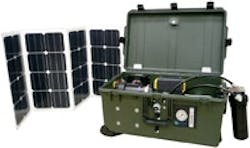About the author: Clark Beek is a technical writer for Spectra Watermakers. Beek can be reached at [email protected] or 415.526.2780.
The Marshall Islands, a scattered group of atolls in the northwestern Pacific, have been plagued with a yearlong, region-wide drought.
On most of the islands, rain catchments supply all the drinking water, while well water is primarily used for washing. After 10 months with little or no rain, Marshall Islanders drank well water reported by the U.S. Environmental Protection Agency (EPA) to have salinity levels 15 times higher than the acceptable range. As the drought dragged on, the well water’s quality continued to fall.
Waterborne illnesses such as diarrhea and hepatitis rose, especially in children and the elderly. Local food staples such as bananas, coconuts, pandanus and breadfruit were dying off, leaving 6,400 lives in danger.
Short-Term Solution
On May 8, 2013, conditions in the northern Marshall Islands were elevated from a State of Drought Emergency to a State of National Disaster. The U.S. Agency for International Development, the International Organization for Migration and Australian Aid routed 30 solar-powered Spectra Aquifer 360 watermaking units to the northern Marshall Islands. Packed in rolling totes for immediate air shipping, the desalination plants were deployed and installed in as little as one hour, providing immediate relief.
The units have been producing a continuous flow of clean, fresh drinking water to Marshallese people since the onset of the emergency.
Long-Term Solution
On tiny Utrik Atoll, one of the northern Marshall Islands, the region’s first permanent solar- and wind-powered water desalination plant was installed four years ago.
In May 2010, Tom Vance of Moana Marine LLC installed two Spectra LB-1800 reverse osmosis (RO) desalination systems, powered by two Bergey XL.1 wind turbines, and Sharp solar panels. The installation on Utrik includes a small building to house the equipment and tools, a storage tank, and a UV sterilizer to again treat the water as it leaves the tank. The system converts seawater into 3,600 gal per day of clean, fresh, EPA-approved drinking water. Utrik’s 485 residents now rely on the water from the desalination systems.
Key Takeaways
The two keys to success for RO desalination on these remote islands are alternative energy and scheduled maintenance.
A desalination plant the size of Utrik’s typically would be powered by a diesel generator, but outer island fuel prices have averaged $8 to $10 per gallon. At those prices, this would mean $30,000 to $75,000 in annual fuel costs. With zero fuel expense, the Spectra installation has paid for itself in fuel savings alone.
The units were designed for energy efficiency and use proprietary energy recovery pumps. This means the small desalination plants can produce a given quantity of water using less energy, which in turn means smaller wind turbines, solar arrays and battery banks, and less expense in shipping them to remote islands.
Local technicians trained by Vance maintain the installation.
“The Utrik technicians are doing a great job,” Vance said. “They value the water treatment facility and are devoted to the operation and maintenance of the machines.”
While maintenance to the system is basic—changing pre-filters, topping battery water, general cleaning and inspections—without maintenance the systems could become unusable.
“It would be like giving a nice car to people on an island where there were no mechanics or hardware stores,” said Bill Edinger, Spectra’s CEO. “They’d drive around for a year or two, but eventually they’d have this nice, broken-down car, still fairly new and in good shape, but inoperable for lack of some basic maintenance and supplies.”
This was not the case on Utrik, where Vance has trained and ingrained maintenance in the local technicians. He returns every year or two to inspect the installation.
With more drought and water crises predicted for the area, Utrik remains a model for drought preparedness and safe, sustainable water production in the Pacific Island region.
Download: Here
